Silver Surges Over $37.25 On Way to Record $50, Gold to $5,000 in 3 or 4 Years?
Commodities / Gold and Silver 2011 Mar 23, 2011 - 01:41 PM GMTBy: GoldCore
 Gold and silver have rallied again today in all currencies but particularly the British pound, Swiss franc and the euro. The euro has fallen on concerns that the eurozone debt crisis may be entering a new phase (see chart below). Silver surged to $37.25/oz its highest nominal price since February 1980 and gold is just shy of its nominal record high of $1444.95/oz.
Gold and silver have rallied again today in all currencies but particularly the British pound, Swiss franc and the euro. The euro has fallen on concerns that the eurozone debt crisis may be entering a new phase (see chart below). Silver surged to $37.25/oz its highest nominal price since February 1980 and gold is just shy of its nominal record high of $1444.95/oz.
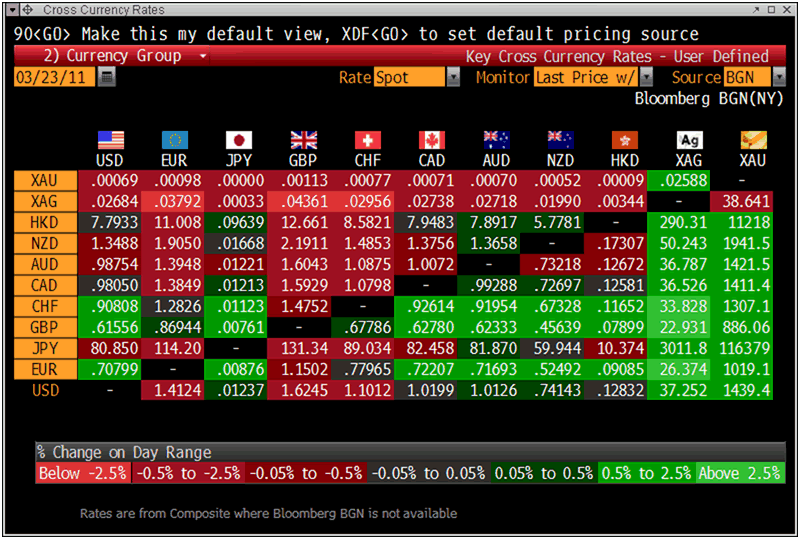
It would be hard to imagine a more bullish scenario for gold and silver given the real macroeconomic and geopolitical uncertainty and risk in the world today. Higher oil prices on geopolitical tension in oil producing regions and talk of QE3 is also strongly supporting the precious metals and leading to safe haven demand. So too is the deteriorating nuclear contamination situation in Japan.
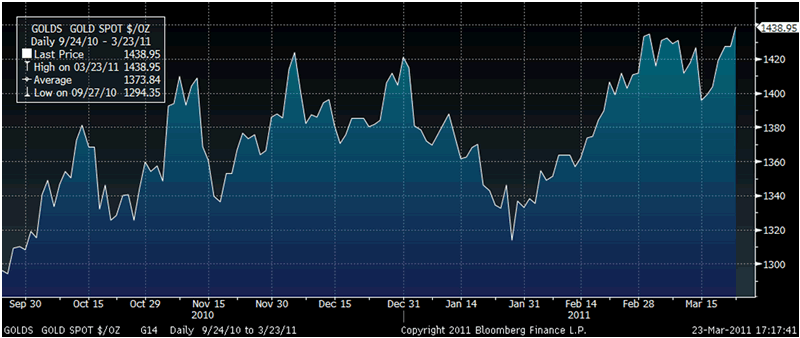
The eurozone debt crisis had not gone away and has reared its ugly head again as Irish and Portuguese debt has been sold aggressively resulting in bond yields rising sharply. The Irish 10 year rose to an all time high of 10.185% on concerns of default.
Reuters reports that respected Rob McEwen, chairman of two gold mining companies, believes that gold will reach $5,000/oz in 3 to 4 years.
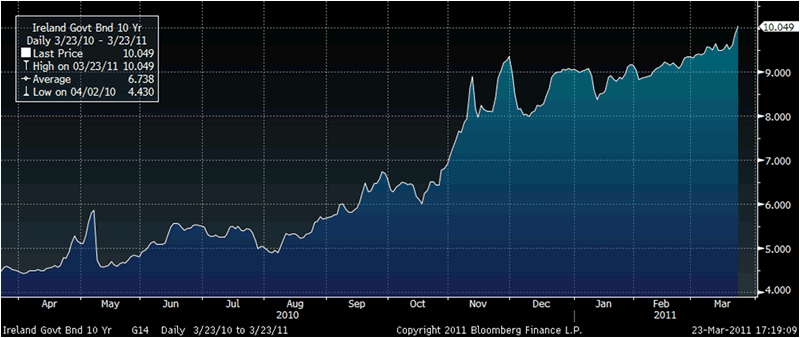
Telling the future remains impossible and we are always wary of specific time predictions. However, GoldCore stand by our prediction in 2004 (when gold was trading below $500/oz) that gold would reach its inflation adjusted high of $2,400/oz and silver would trade over $100/oz between 2012 and 2020.
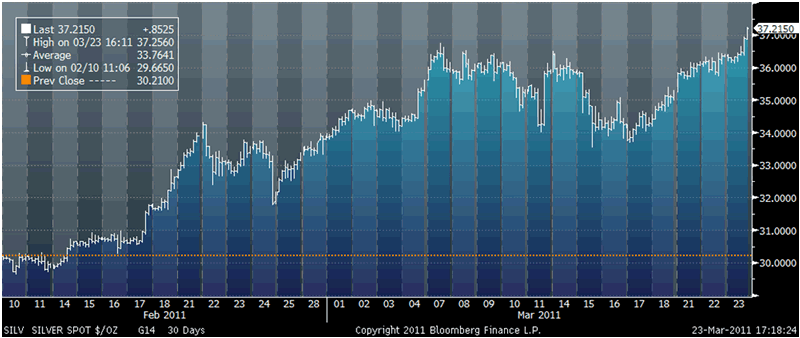
The degree of macroeconomic, geopolitical and environmental uncertainty in the world today is worse than even during the turbulent ‘Bush years’. Indeed, it is worse than any time in modern history – possibly since World War II. These conditions are a “perfect storm” for the precious metals.
Despite the bullish conditions, gold and silver remain taboo in most of the media and gold and particularly silver are only covered in the specialist financial press.
Gold and silver remain fringe investments owned a tiny percentage of investors and savers in the western world. Unlike in most of Asia where gold is correctly seen as money, a store of value and as essential financial insurance to protect against the economic mismanagement of bankers and politicians.
Despite the bullish conditions, investors should avoid leverage and taking speculative punts on any one asset class including gold and silver. Volatility is likely to surge in the coming months.
Diversification including allocations to gold and silver bullion has never been more important.
NEWS
(Bloomberg) -- Silver Climbs to $36.78 An Ounce, Highest Since February 1980
Silver for immediate delivery climbed as much as 41.75 cents, or 1.2 percent, to $36.78 an ounce by 2:33 p.m. in London, the highest price since February 1980.
(Reuters) -- Gold May Rise to $5,000 in 3-4 Years, McEwen Says
The price of gold may hit $5,000 per ounce, nearly three times current levels, in three to four years, as demand from sovereign states, central banks and exchange-traded funds (ETFs) rises, the chairman of two Canadian gold mining companies said.
"Gold is used as insurance for bad governments," Rob McEwen, chairman and chief executive of Minera Andes Inc and US Gold Corp, told Reuters on the sidelines of the Mines and Money conference in Hong Kong on Wednesday.
Gold is traditionally used as a hedging tool against inflation and economic uncertainty. The yellow metal has also been a favorite investor hedge against loose monetary policies in the wake of the global financial crisis.
McEwen said gold was in the middle of a super cycle that could end by 2015, adding that the length of the gold super cycle and the $5,000 forecast were based on historical gold prices and the ratio of the Dow stock index against gold since 1970.
McEwen founded Canada's top gold miner Goldcorp Inc. He left the company in 2005, cashing in for a little over $200 million.
He said about 90 percent of his personal assets were in physical gold, adding the he owned a 31 percent stake in Minera and a 20 percent stake in US Gold, both headquartered in Toronto.
US Gold mines gold and silver in the United States and Mexico. Minera has a project in Argentina.
McEwen said he believed that countries such as China, Russia and India would buy gold as part of their foreign exchange reserves.
If China wanted the yuan to become an international reserve currency, the government may need to put 10 percent of its foreign exchange reserves in gold, he said.
The world's second-biggest economy, China holds less than 2 percent of its 2.85 trillion foreign exchange reserves in gold, which have stayed at 33.89 million ounces since April 2009 according to official figures.
He said, however, that global gold production would continue to be limited by high costs and tighter regulatory controls.
Spot gold was steady at about $1,427 per ounce at 0630 GMT (2:30 a.m. ET) on Wednesday, within striking distance of its record $1,444.40 per ounce set on March 7.
Nick Holland, chief executive of the world's fourth-largest listed gold miner Gold Fields Ltd, said on Tuesday that the gold could hit $1,500 and the industry was not making a huge amount of money at current prices.
(Reuters) -- Gold steady on Middle East crisis
Gold prices steadied on Wednesday, as escalating unrest in the Middle East and North Africa underpinned safe-haven demand, but a modest rebound in the dollar could weigh on the sentiment as fears on Japan's nuclear crisis eased.
The troubles in the Middle East turned increasingly violent with Syrian troops opening fire on protesters and Yemen's president warning that the country would slip into civil war if he was forced to quit.
"Gold is still taking its cue from the situation in the Middle East," said Ong Yi Ling, an analyst at Phillip Futures, adding that it could increase safe-haven flows into the precious metal.
Oil prices have moved in tandem with gold since the Middle East tensions broke out at the end of January. Lofty oil prices have stoked worries of inflation down the road, adding to gold's allure as an inflation hedge.
Spot gold was little changed at $1,428.50 an ounce by 0656 GMT (2:56 a.m. ET). U.S. gold futures was nearly flat at $1,428.80.
Bullion has been moving in a narrow range of $4 in the past two sessions, lacking momentum for a further rise on easing fears over Japan's nuclear crisis, even though the battle to contain the problem was ongoing and concerns on food contamination are rising.
Profit-taking was spotted as prices rose toward $1,430, seen as a key resistance level, traders said.
"Investors don't know what to do -- we see profit-taking at the high price range, but fears of inflation as well as the Middle East crisis triggers buy-back by speculators when prices go down," said a Hong Kong-based dealer.
Improving outlook for developed economies, including the United States, has prompted some investors to move into riskier assets such as equities, he added.
Technical analysis showed that unless gold effectively breaks above the pivotal resistance at $1,435, market sentiment might be bearish, pressuring prices down to $1,416, said Reuters market analyst Wang Tao.
Investors are also eyeing the currency market. The dollar index .DXY edged up after sinking to a 15-month low in the previous session, as the euro hovered below a 4- month high.
Sovereign debt problems in Portugal and Ireland sapped appetite for the single currency, as Portugal's parliament will vote on the government's latest austerity measures on Wednesday.
A rebound in the dollar could hurt sentiment on commodities.
Spot silver inched down 0.3 percent to $36.22, just off the 31-year high of $36.70 hit on March 7.
(Financial Times)-- Survey says lower confidence in more gold gains
Investors have cooled on gold as their attention turns from financial risks to geopolitical turmoil, according to a leading survey.
None of the roughly 100 European institutional investors queried in an annual Barclays Capital survey said gold would be the best-performing commodity in 2011. The metal received the second-highest share of votes for worst performer after natural gas.
The ambivalence towards gold follows its ascent to records, in nominal terms, above $1,400 a troy ouce. The rise in part reflected investor concerns about inflation and the value of paper currencies.
Inflation has returned to leading economies but threats to key commodity supplies, such as grains and crude oil, are now dominating headlines.
Kevin Norrish, managing director for commodities research at Barclays in London, said: “It’s a pretty consistent, clear message. Certainly this group of investors doesn’t believe the gold story is going to continue.
“The set of risks that people are concerned about now is changing.
“Last year [these were] very much reflecting the aftershocks of the financial crisis, particularly sovereign debt,” he said.
Barclays forecasts gold averaging $1,520 an ounce at year-end. On Tuesday it was at $1,427.
Investors have been acting on their views. The $55bn SPDR Gold Trust, the largest gold exchange-traded fund, saw $3bn in outflows in January and February, according to National Stock Exchange data.
Barclays conducted the survey over the three weeks ending on March 15, as battles intensified in Libya, the world’s 12th largest oil exporter.
Crude oil received the most votes as the best performing commodity this year, followed by grains, which have surged on tight global supplies of corn and soyabeans.
More than two-in-five said geopolitics presented the greatest risk of rising prices to commodity markets, while a quarter identified excessive global liquidity as the biggest danger.
The majority of survey participants said a slowdown in China looms as the biggest factor that would push down commodity prices.
Globally, investors have $375bn in commodities after $62bn in inflows last year, Mr Norrish said.
(Reuters via the Nation) -- Silver climbs to 31-year high
Gold on Wednesday hit its highest since early March and silver struck a 31-year peak as investors sheltered in precious metals from weak data, Middle East unrest and a key vote threatening Portugal's government.
Spot gold was bid at $1,439.44 a troy ounce at 17:07 SA time from $1,429.50 late in New York on Tuesday. The precious metal hit a session high of $1,440.90, its highest since March 7 when it scored a record peak of $1,444.40 an ounce.
Tracking bullion, spot silver hit a session high of $36.85 an ounce, its highest since 1980.
“As long as we still have all this uncertainty it lends good support to the gold story,” Saxo Bank senior manager Ole Hansen said as oil prices stayed high, fighting in Libya escalated and unrest simmered across the Middle East.
“There is a chance now that we could move to the $1,450 level,” he added.
Weak economic data boosted investors' flight to gold as a safe haven from risk. Figures showed new U.S. single-family home sales unexpectedly fell in February to hit a record low and that euro zone consumer confidence declined in March.
The latest flurry of gold purchases was also bolstered by the expectation Portugal's parliament would reject the government's latest austerity measures, setting the stage for the possible collapse of the minority Socialist administration ahead of a European summit.
Also hitting risk appetite, European Union leaders are set to delay a decision on how to strengthen their multi-billion euro rescue fund beyond the summit this week.
“Today there is focus on Portugal. There are debt problems more generally in the western world and of course we should not forget the Middle East, which also leads to safe-haven flows,” said Christin Tuxen, analyst at Danske Bank.
“Longer term, the fact that interest rates are on the rise generally will make the opportunity cost of investing in gold higher, making it less attractive.”
OIL SUPPLY
Conflict in the Middle East has helped gold market sentiment and boosted oil prices because of worries about supply disruptions in the region.
Gold is used as a hedge against inflationary pressures, often triggered by rising oil prices. Brent crude oil dipped slightly but, at $115 a barrel, was nearing recent 2-1/2 year highs of around $120.
Forecasts of stronger industrial demand have helped silver prices climb. Spot silver was bid at $36.81 an ounce from $36.34 late on Tuesday.
“While many market participants are impressed by silver's industrial and retail demand, and are concerned about physical shortages, another portion believe there is too much speculative noise in the market right now,” UBS said in a note.
Platinum was bid at $1,745.5 an ounce from $1,732.00 and palladium at $738.65 from $733.00.
Both platinum and palladium are used in autocatalysts and have come under pressure since Japan's March 11 earthquake and tsunami shut car factories in Japan.
Toyota Motor Co has halted operations at its 12 main assembly plants in Japan until at least Saturday, which will result in lost production of 140,000 vehicles.
“Japan accounted for 15 percent of global platinum consumption last year, and demand in the short term will be weaker following the closure of industry after the earthquake/tsunami,” Credit Agricole said in a note.
“Any disruptions to the supply of key components imported from Japan would also affect industrial production/manufacturing activity in other parts of the world.” - Reuters
GOLDNOMICS
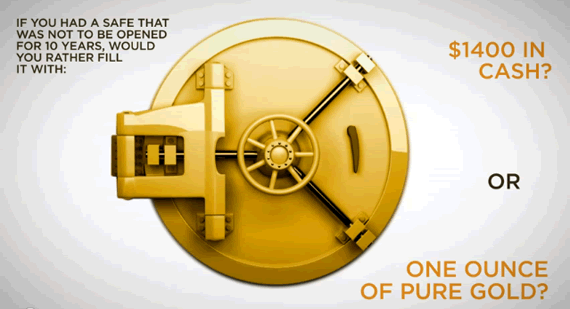
'GoldNomics' can be viewed by clicking on the image above or on our YouTube channel:
www.youtube.com/goldcorelimited
This update can be found on the GoldCore blog here.
Mark O'Byrne
Director
IRL |
UK |
IRL +353 (0)1 632 5010 |
WINNERS MoneyMate and Investor Magazine Financial Analysts 2006
Disclaimer: The information in this document has been obtained from sources, which we believe to be reliable. We cannot guarantee its accuracy or completeness. It does not constitute a solicitation for the purchase or sale of any investment. Any person acting on the information contained in this document does so at their own risk. Recommendations in this document may not be suitable for all investors. Individual circumstances should be considered before a decision to invest is taken. Investors should note the following: Past experience is not necessarily a guide to future performance. The value of investments may fall or rise against investors' interests. Income levels from investments may fluctuate. Changes in exchange rates may have an adverse effect on the value of, or income from, investments denominated in foreign currencies. GoldCore Limited, trading as GoldCore is a Multi-Agency Intermediary regulated by the Irish Financial Regulator.
GoldCore is committed to complying with the requirements of the Data Protection Act. This means that in the provision of our services, appropriate personal information is processed and kept securely. It also means that we will never sell your details to a third party. The information you provide will remain confidential and may be used for the provision of related services. Such information may be disclosed in confidence to agents or service providers, regulatory bodies and group companies. You have the right to ask for a copy of certain information held by us in our records in return for payment of a small fee. You also have the right to require us to correct any inaccuracies in your information. The details you are being asked to supply may be used to provide you with information about other products and services either from GoldCore or other group companies or to provide services which any member of the group has arranged for you with a third party. If you do not wish to receive such contact, please write to the Marketing Manager GoldCore, 63 Fitzwilliam Square, Dublin 2 marking the envelope 'data protection'
GoldCore Archive |
© 2005-2022 http://www.MarketOracle.co.uk - The Market Oracle is a FREE Daily Financial Markets Analysis & Forecasting online publication.



